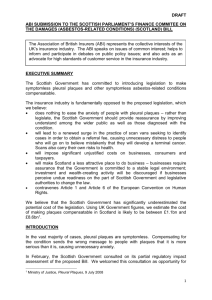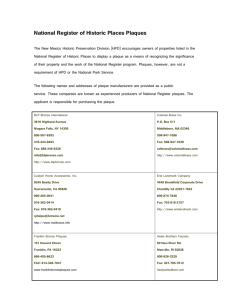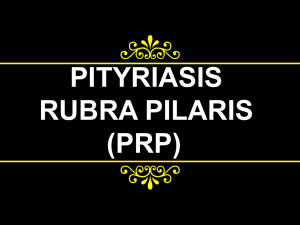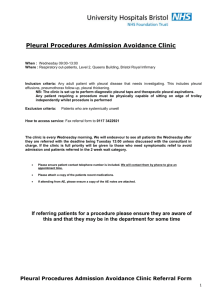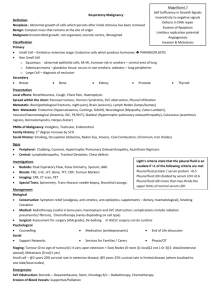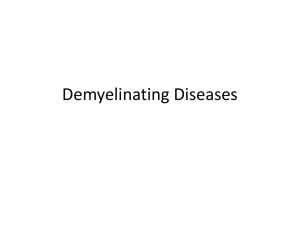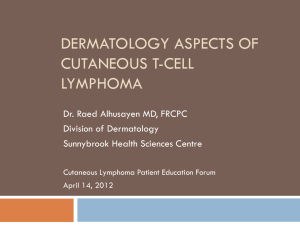View response (doc 70kB) - Association of British Insurers
advertisement
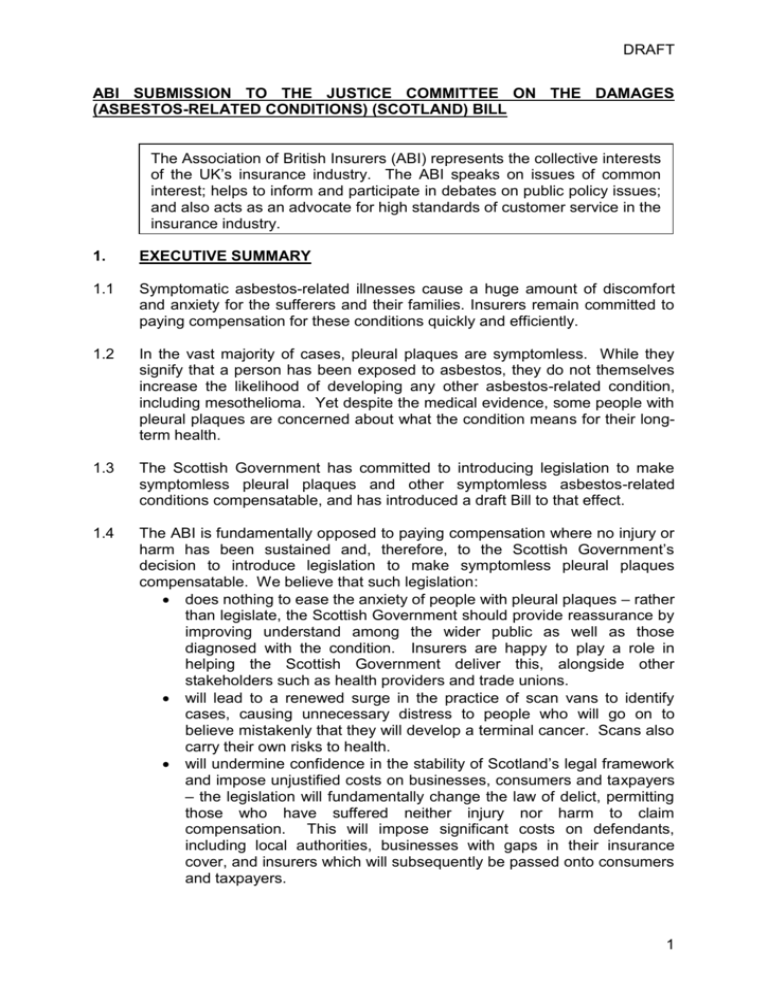
DRAFT ABI SUBMISSION TO THE JUSTICE COMMITTEE ON THE DAMAGES (ASBESTOS-RELATED CONDITIONS) (SCOTLAND) BILL The Association of British Insurers (ABI) represents the collective interests of the UK’s insurance industry. The ABI speaks on issues of common interest; helps to inform and participate in debates on public policy issues; and also acts as an advocate for high standards of customer service in the insurance industry. 1. EXECUTIVE SUMMARY 1.1 Symptomatic asbestos-related illnesses cause a huge amount of discomfort and anxiety for the sufferers and their families. Insurers remain committed to paying compensation for these conditions quickly and efficiently. 1.2 In the vast majority of cases, pleural plaques are symptomless. While they signify that a person has been exposed to asbestos, they do not themselves increase the likelihood of developing any other asbestos-related condition, including mesothelioma. Yet despite the medical evidence, some people with pleural plaques are concerned about what the condition means for their longterm health. 1.3 The Scottish Government has committed to introducing legislation to make symptomless pleural plaques and other symptomless asbestos-related conditions compensatable, and has introduced a draft Bill to that effect. 1.4 The ABI is fundamentally opposed to paying compensation where no injury or harm has been sustained and, therefore, to the Scottish Government’s decision to introduce legislation to make symptomless pleural plaques compensatable. We believe that such legislation: does nothing to ease the anxiety of people with pleural plaques – rather than legislate, the Scottish Government should provide reassurance by improving understand among the wider public as well as those diagnosed with the condition. Insurers are happy to play a role in helping the Scottish Government deliver this, alongside other stakeholders such as health providers and trade unions. will lead to a renewed surge in the practice of scan vans to identify cases, causing unnecessary distress to people who will go on to believe mistakenly that they will develop a terminal cancer. Scans also carry their own risks to health. will undermine confidence in the stability of Scotland’s legal framework and impose unjustified costs on businesses, consumers and taxpayers – the legislation will fundamentally change the law of delict, permitting those who have suffered neither injury nor harm to claim compensation. This will impose significant costs on defendants, including local authorities, businesses with gaps in their insurance cover, and insurers which will subsequently be passed onto consumers and taxpayers. 1 DRAFT will make Scotland a less attractive place to do business – businesses require assurance that the Government is committed to a stable legal environment; investment and wealth-creating activity will be discouraged if businesses perceive undue readiness on the part of Scottish Government and legislative authorities to change the law. Scottish consumers will suffer through reduced choice compared to their counterparts elsewhere in the UK contravenes Article 1 and Article 6 of the European Convention on Human Rights 1.5 We urge the Justice Committee to highlight to Parliament the issues associated with this Bill. 2. INTRODUCTION 2.1 On 17 October 2007 the House of Lords, which included two Scottish Law Lords: Rodgers and Hope, unanimously concluded that pleural plaques do not give rise to a cause of action under the law of negligence (delict). 2.2 They reached this conclusion on the basis of medical evidence that showed that pleural plaques: are, except in exceptional cases, symptomless and therefore do not result in any pain, suffering or loss of amenity neither lead to, nor increase susceptibility to, any other asbestosrelated condition. 2.3 The Scottish Government is committed to introducing legislation to make asymptomatic asbestos-related conditions compensatable. The ABI is fundamentally opposed to that position. 2.4 In February, the Scottish Government consulted on its partial regulatory impact assessment of the proposed Bill. We welcomed this consultation as opportunity for the Scottish Government to consider afresh the advantages and disadvantages of legislative action. 2.5 More than three-quarters of the responses to that consultation opposed the Bill. We are concerned, however, that the issues raised in those responses have not been properly considered. 2.6 Firstly, we believe that compensating someone with pleural plaques will only perpetuate any anxiety they might feel about the diagnosis; education, not legislation, is the best way to reassure a person that pleural plaques does not mean that they are going to develop mesothelioma or any other symptomatic asbestos-related condition. 2.7 Secondly, the Bill will undermine business confidence in the extent to which they can rely on a stable legal framework in Scotland, and will affect the competitiveness of Scottish businesses compared to their counterparts in the rest of the UK. 2 DRAFT 2.8 Thirdly, the Bill contains retrospective provisions which contravene Articles 1 and 6 of the European Convention on Human rights, which precludes any interference by the legislature with the administration of justice designed to influence the determination of the dispute. 3. HELPING PEOPLE WITH PLEURAL PLAQUES 3.1 Pleural plaques are nearly always symptomless1, and they neither lead to, nor increase susceptibility to, any other condition. 3.2 Despite the medical evidence that pleural plaques are benign (see Annex A), there is a great deal of confusion among people with the condition and their families about what a diagnosis of plaques really means for their health. 3.3 Some people are concerned that having pleural plaques are the first step towards developing a more serious asbestos-related condition, such as mesothelioma. This is not the case, as the medical evidence shows. It is not the plaques themselves that increase a person’s risk, but rather the exposure to asbestos. 3.4 The best way to allay the concerns of people with pleural plaques is to improve their understanding of the condition. This can really only be achieved through ensuring that those people and organisations who communicate with sufferers – the Government, health providers, trade unions - distil the same messages, namely that plaques are usually symptomless and do not increase susceptibility to any other asbestos-related illnesses, including mesothelioma. However, legislation to make plaques compensatable sends a very different message – the fact that a condition is worthy of compensation suggests that it is more serious than it really is. 3.5 This was a point made by Anthony Seaton, Emeritus Professor of Environmental and Occupational Medicine at the University of Aberdeen: “Confusion arises because exposure to asbestos is also associated with the risk of serious fatal diseases, most notably mesothelioma, and most people with this disease also have pleural plaques. It is understandable that individuals with plaques can be worried about their prognosis if they are given misinformation on their significance. The change in case law that led to individuals with pleural plaques receiving money for a non-disease caused problems in their management. While giving appropriate reassurance and explaining the risks of other asbestos-related diseases in relation to the risks of much more likely diseases, we were obliged to advise them to consult a lawyer – a mixed message with the obvious consequence of causing anxiety. The main beneficiaries have been lawyers and expert witnesses such as me. I believe we have better things to do, to prevent real diseases. 1 The presence of pleural plaques does not normally occasion any symptoms. Very occasionally, in fewer than 1% of cases, the patient may be aware of an uncomfortable grating sensation on respiration (Lord Philips CJ, and Lord Justice Longmore, Court of Appeal judgment in Rothwell, January 2006) 3 DRAFT “There is a risk that the desirability of raising awareness of the nature of pleural plaques and allaying unnecessary concerns could be undermined by the provision of compensation, as this could send mixed messages about the nature of the condition and increase concerns.2” 3.6 Rather than legislating the Scottish Government should be working with the NHS, trade unions and sufferer support groups to ensure widespread awareness of current medical knowledge. Insurers would be happy to play a role in delivering this. 4. UNDERMINING BUSINESS CONFIDENCE A stable legal framework? 4.1 The Scottish Government has said that it is committed to creating a competitive environment within which business can flourish; to attracting inward investment; and to building a culture of entrepreneurship. It has also spoken of the potential to develop Scotland as a forum for international dispute resolution. The use of the legislative power of the state to overturn judicial decisions is inconsistent with these stated aims and, in particular, with their long-term achievement. 4.2 Legal certainty is extremely important to liability insurers. Liability insurance is inextricably linked to the law of delict. Without liability insurance, it is doubtful that delict liability as we know it would exist as those who had been wronged would be unable to receive the appropriate compensation for their harm. Undermining the fundamental principles of the law of delict starts to challenge and undermine the whole compensation system. Ultimately, it could result in those with genuine injuries or harm being unable to obtain satisfactory redress and / or businesses collapsing under the weight of litigation and compensation bills. 4.3 Further, businesses require assurance that the Government is committed to a stable legal environment; investment and wealth-creating activity will be discouraged if businesses perceive undue readiness on the part of Government and legislative authorities to change the law. It is the retrospective nature of the legislation that creates particular unease for the future. Unjustified costs 4.4 2 The Scottish Government has significantly underestimated the level of unjustified costs that the Bill will impose on Scottish businesses, consumers and taxpayers. Higher costs for insurers will be passed onto employers’ liability policyholders in the form of higher premiums , while higher costs for local authorities will fall to taxpayers. Professor Anthony Seaton, ‘Close scrutiny needed on asbestos-related disease’ in The Scotsman, 30 October 2007 4 DRAFT 4.5 The Financial Memorandum makes assumptions about the potential number of future claims based on the number of sisted cases. It suggests there will be approximately 200 claims per year. However, this underestimates the extent of the problem because: it does not take into account the sharp fall in the number of claims following the Court of Appeal judgment in 2006 (6,000 claims in 2005, fell to 2,250 in 20063 Scotland has approximately 30% of total UK-asbestos liabilities. We estimate that had the test cases not been brought, the annual number of claims in Scotland would be closer to 1,800 than the 200 the Financial Memorandum suggests it does not deal adequately with the potential for forum shopping. While the Policy Memorandum dismisses concerns about forum shopping, it is vague about how it will do this. This creates further uncertainty about the potential number of claims. 4.6 A number of studies support the notion that the potential for underestimation of future claims is considerable. Some of these are referenced in Annex B. 4.7 The underestimation of the number of potential claims prohibits accurate forecasting of the cost of the legislation. The Financial Memorandum suggests that the annual cost to defendants of compensating plaques would between £5.5m and £6.5m, however: 4.8 the annual cost to the UK is estimated to be between £252m and £2bn4 Scotland has approximately 30% of the UK’s asbestos liabilities; we therefore estimate that a more realistic range on the annual cost of this legislation to defenders would be £76m to £607m. A high proportion of these costs would fall to insurers, which would be passed on to employers’ liability policyholders in the form of higher premiums; some insurers may even choose to exit the Scottish liability market. This could undermine the competitiveness of Scottish businesses compared to their counterparts elsewhere in the UK where there might be cheaper and wider availability of cover. [can we calculate as % of Scottish EL premium income?] 4.9 Further, many companies with gaps in their insurance cover as well as local authorities will find themselves liable for a portion of any claims. Where the local authority incurs costs, ultimately it will be the taxpayer who foots the bill. [can we estimate proportion of claims that will fall to LAs?] 4.10 The Scottish Government also has a significant degree of liability for exposing former employees to asbestos via the Ministry of Defence and the Department 3 Institute of Actuaries, presented at the GIRO conference, October 2007 (approximate figures) ABI estimates, based on data contained in the Ministry of Justice’s consultation paper, Pleural Plaques, 9 July 2008 4 5 DRAFT for Business, Enterprise and Regulatory Reform, whose powers are devolved to the Scottish Government who holds the residual historic liabilities for the shipyards, docks and the steel industry. The burden of this would fall on the Scottish taxpayer. [can we estimate proportion of Scottish Govt liabities?] 4.11 The impact of the legislation on run-off insurance companies and their claimants should also be borne in mind. Run-off insurance companies no longer underwrite business in a particular line and, therefore, are effectively closed funds with finite resources. This means that increased levels of payments made to those with symptomless conditions will inevitably reduce the amounts available to pay those who develop more serious conditions, including mesothelioma. [do we know approximately what proportion of claimants this might effect?] 5. UNINTENDED CONSEQUENCES Changing the law of delict 5.1 The Scottish Government suggests that the Damages will ensure legal consistency with the situation pre-Johnston. This is incorrect. 5.2 The law of delict requires that for damage to be compensatable, it must be more than de minimis, which is to say that it is required to reach a threshold of seriousness if it is to justify the intervention of the law. Compensation has therefore only ever been granted where it can be shown that a claimant has sustained damage that is more than minimal. Medical evidence now exists which shows that pleural plaques have no effect on health at all; consequently, the ‘more than minimal’ criterion is not met. 5.3 In their judgment, the Lords applied the existing law of delict to the latest medical evidence about the effect of plaques on a person’s health. This – not the proposed Bill – demonstrates legal consistency. Making benign pleural plaques compensatable represents a fundamental change to the law. Wider implications 5.4 Interference with the fundamental principles on which the Law Lords’ decision was based will be used as a precedent to argue for compensation in other situations (see Annex C), with significant cost implications for businesses, consumers and taxpayers. For example, it is likely to lead to calls for compensation in other circumstances where no actionable damage has yet occurred, such as simply for exposure to asbestos, and the worry from such exposure, regardless of whether this had resulted in any symptoms or injury. Any such calls would be hard to resist on grounds of fairness once the Bill is passed. 6 DRAFT 5.5 It will also raise the possibility of compensation claims being made much more widely for the risk of an illness occurring, or for worry that something might happen, for example, in relation to the effects of passive smoking in the workplace or exposure to the sun in the building industry or other jobs involving outdoor work. 5.6 Anxiety is not compensatable under law (see Annex D). If developments in the law of this nature occurred, this could considerably increase the level of litigation and the possibility of weak or spurious claims and could have damaging effects on business and the economy. Even if such claims were not to succeed, the cost of resisting them would be significant. 5.7 The cost of these new claims cannot be quantified as we do not know how many or which conditions would become actionable. The proposed legislation would contravene defendants’ human rights 5.8 The provisions of the draft Bill have retrospective effect and apply to cases which have not been settled, or determined by a court, before the date the legislation comes into force. This would include all those whose cases had been sisted pending the House of Lords’ decision, or the Court of Appeal decision, or had been withdrawn/discontinued, or who had not commenced proceedings because of the Court of Appeal or House of Lords’ decision. 5.9 Retrospective provisions of this nature raise issues in relation to the European Convention on Human Rights. Article 6 enshrines the principle of the rule of law and the notion of fair trial, both of which are precluded by any interference by the legislature with the administration of justice designed to influence the judicial determination of the dispute. This interference with settled arrangements breaches the Convention. [need to insert something re Article 1] 6. CONCLUSION 6.1 The Damages Bill fails to address the real issues for people with pleural plaques and is based upon a belief that paying money to someone in some deals with this condition. It does not respond to the anxieties people have about pleural plaques; it risks damage to the Scottish economy, imposing significant costs on the Scottish taxpayer, consumer and taxpayer; and contravenes the European Convention on Human Rights. 7 DRAFT ANNEX A THE MEDICAL EVIDENCE A.1 The medical evidence on pleural plaques is uncontested by medical experts, and undisputed by claimants and their lawyers. In Johnston, Dr Robin Rudd, a consultant physician in medical oncology and respiratory medicine, acting for the appellants, and Dr John Moore-Gillon, a consultant physician in respiratory medicine and vice-president of the British Lung Foundation, acting for the respondents, prepared a joint report5 which stated inter alia “we find that we are in general agreement and we do not consider that there are any material differences between our medical views regarding pleural plaques”. The substance of their evidence was as follows: The pathogenesis of pleural plaques, while undoubtedly involving a response to asbestos fibres, is not entirely clear but the presence of plaques does not necessarily imply that any damage has been caused to the lungs The plaques (bland fibrous tissue usually situated on the parietal pleura) do not, save in a very rare condition where they are extensive and confluent, impair the ability of the visceral and parietal pleura to slide easily over each other. In almost 25 years of practising in the field of respiratory medicine, having seen many hundreds of asbestosexposed individuals, Dr Moore-Gillon had seen ‘only a handful’ of cases where pleural plaques were associated with any symptoms. This is because they have a covering of mesothelial cells providing a low-friction surface which, together with a lubricant of pleural fluid, permits this easy movement. Thus the ease and freedom of the lungs’ ability to expand and contract is unaffected. Though individual plaques may grow they do no (and cannot) multiply or progress to one of the other recognised asbestos-related conditions. They amount to a ‘biological cul-de-sac’. The plaques themselves are therefore wholly benign and asymptomatic. The association of plaques with physical symptoms such as breathlessness is almost invariably explained by the concurrent presence of asbestosis or other co-morbidity unrelated to asbestos Pleural plaques are a ‘marker’ of exposure to asbestos fibres because it is accepted from pathological and epidemiological studies that they are associated with exposure. For that reason only, they are also associated with a risk of serious asbestos-related disease occurring in the future. The magnitude of that risk is assessed, however, by reference to the age and occupational history of the patient and not by the presence of plaques themselves. A.2 In fact, the lifetime risk of a person who has had occupational exposure to asbestos developing mesothelioma is low – between three and five percent. To put this in context, the lifetime risk of a male developing prostrate or lung cancer 5 Drs Rudd & Moore-Gillon in Rothwell, 13 July 2004 8 DRAFT is seven percent and eight percent respectively; the lifetime risk of a female developing breast cancer is 11%6. 6 UK Statistics Authority 9 DRAFT ANNEX B THE PREVALENCE OF PLAQUES B.1 In his report of 10 November 2004, Dr Moore-Gillon suggested that there are now about 1,500 new cases of mesothelioma diagnosed in the UK each year. There must accordingly be far more than 1,500 cases of pleural plaques arising each year. However, because they are asymptomatic many, and almost certainly most, are not at present diagnosed. When they are diagnosed it is usually as an incidental finding on a chest radiograph carried out for other reasons. For every person that develops mesothelioma in any given period there will be 20-50 people developing plaques i.e. 30,000 to 75,000 per year7. Given that approximately 30% of the asbestos liabilities are Scotland, between 9,000 and 22,000 of these are likely to be in Scotland. B.2 Professor Mark Britton, a consultant physician and Chairman of the British Lung Foundation, reported that a pathologist had estimated that 10% of the cadavers he saw had pleural plaques8. B.3 Professor Tony Newman Taylor (one of the most pre-eminent chest physicians in the UK and previously chair of the Industrial Injuries Advisory Council) states that about one-third to one-half of those occupationally exposed to asbestos will have calcified pleural plaques thirty years after first exposure9 B.4 A study by SJ Chapman concludes “Pleural plaques typically develop 20 to 30 years after exposure, and their incidence increases with longer duration of exposure. They are found in as many as 50% of asbestos-exposed workers, but may also occur after low-dose exposures. The total surface area of pleural plaques measured via CT does not appear to be related to cumulative asbestos exposure”10. B.5 A study of autopsy results for males over 70 years old near Glasgow showed a 51.2% incidence of pleural plaques. Note that this did not specifically look at those occupationally exposed to asbestos, however a relatively high proportion of workers in Glasgow have been exposed to asbestos due in particular to the shipyards11. B.6 A study by Chailleux & Letourneux cites a 25% incidence of benign pleural lesions in population intermittently exposed to asbestos12. 7 Dr John Moore-Gillon, 10 November 2004 Quoted at a briefing in Westminster on 26 March 2008 9 3 Dec 2007 House of Commons debate, Michael Clapham (Lab): reading an email from Professor Tony Newman Taylor: "You may be interested to know that about a third to one half of those occupationally exposed to asbestos will have calcified pleural plaques thirty years after first exposure. After twenty years, 5 to 15 per cent. will have uncalcified pleural plaques". 10 Chapman, SJ et al, "Benign Asbestos Pleural Disease", Curr Opin Pulm Med 2003:9(4), 266-271 11 Cugell, DW and DW Kamp, "Asbestos and the Pleura: A Review", Chest 2004:125, 1103-1117 12 Chailleux & Letourneux (Rev Mal Resp 1999) 8 10 DRAFT ANNEX C ACTIONABLE DAMAGE IS MORE THAN DE MINIMIS C.1 The law of delict requires that for damage to be compensatable, it must be more than de minimis, which is to say that it is required to reach a threshold of seriousness if it is to justify the intervention of the law: “A claim in tort based on negligence is incomplete without proof of damage. Damage in this sense is an abstract concept of being worse off, physically or economically, so tha compensation is an appropriate remedy. It does not mean simply a physical change, which is consistent with making one better, as in the case of a successful operation, or with being neutral, having no perceptible effect upon one’s health or capability. “How much worse off must one be? An action for compensation should not be set in motion on account of a trivial injury. De minimis non curat lex”13. C.2 Pleural plaques do not reach this threshold – as Holland J found in Rothwell: “I start by rejecting any notion that pleural plaques per se can be found a cause of action”. C.3 As the Lord Phillips CJ found when the case was heard at the Court of Appeal: “It is common ground in this case, rightly in our view, that the development of pleural plaques is insufficiently significant, of itself, to constitute damage upon which a claim in negligence can be founded”. C.4 As Lord Hope of Craighead found in Johnston: “While the pleural plaques can be said to amount to an injury or a disease, neither the injury nor the disease was in itself harmful. This is not a case where a claim of low value requires the support of other elements to make it actionable. It is a claim which has no value at all”. C.5 And as Lord Uist later acknowledged in his judgment in Wright v Stoddard International plc: “It is not that pleural plaques cause harm which is de minimis: it is that they cause no harm at all”. 13 Lord Hoffman in Johnston 11 DRAFT ANNEX D ANXIETY IS NOT A BASIS FOR A CAUSE OF ACTION D.1 It is uncontested by medical experts that pleural plaques are harmless. It follows that pleural plaques do not therefore constitute actionable damage. D.2 However, the Bill seeks to ensure that people get compensation for anxiety that may arise about the risk of contracting a serious asbestos-related disease as a result of a diagnosis of plaques. D.3 But anxiety is not a basis for a cause of action, even where aggregated. The law only compensates for anxiety where it is part of another more serious injury or disease which would be compensatable alone and without the presence of the said anxiety. D.4 Johnston affirmed the principle established by the House of Lords in Hicks v Chief Constable of the South Yorkshire Police that mere anxiety about a risk of further damage is not itself compensatable: “There are also cases which suggest that he may be able to recover damages for anxiety consequent upon an actionable injury. But recovering is predicated upon the existence of actionably injury. There is nothing to suggest that a claimant can rely upon the single action rule to sue in circumstances in which he does not have a cause of action in the first place”. D.5 The Lords in Johnston also rejected any arguments that the condition could be ‘aggregated’ with the risk of future asbestos disease and/or the anxiety experienced in relation to such risk. Since neither the plaques alone, nor the risk of future damage, nor anxiety about the risk are individually actionable, it follows that they are not collectively actionable either: “It would be easy to dismiss this argument by applying the simplest of all mathematical formulae: two or even three zeros, when added together, equal no more than zero. It is not possible, by adding together two or more components, none of which in itself is actionable, to arrive at something which is actionable”14. D.6 14 Thus introducing legislation to make anxiety about pleural plaques compensatable will require fundamental changes the law of delict. Lord Hope of Craighead 12
